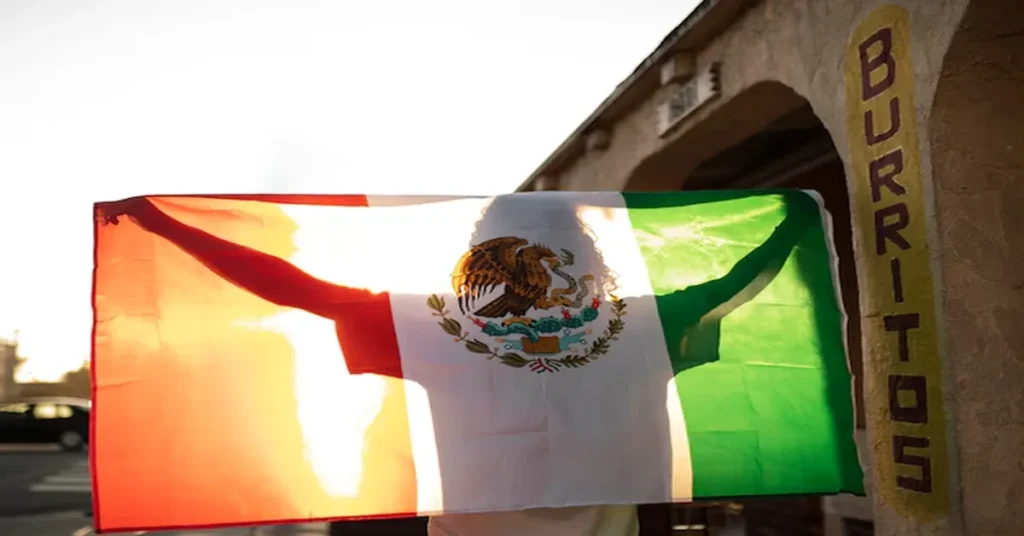The flag of Mexico, known as “La Bandera de México”, is a powerful and revered national symbol. More than a piece of fabric, it represents the soul of the Mexican nation: its history, culture, and the unwavering spirit of its people. This article takes an in-depth look at the Mexican flag, exploring its design, symbolism, historical evolution, importance in national identity, and its place in modern society.
The Design of the Mexican Flag
Color Scheme and Layout
The current flag of Mexico is a vertical tricolor featuring three equal bands:
- Green on the hoist side
- White in the center
- Red on the fly side
Centered in the white band is the national coat of arms, which depicts a golden eagle perched on a prickly pear cactus devouring a snake.
Symbolism of the Colors
The colors of the Mexican flag hold deep historical and cultural meanings. Though interpretations have varied over time, the most widely accepted meanings today are:
- Green: Hope and prosperity
- White: Unity and purity of the Mexican people
- Red: The blood of national heroes who fought for independence
The Coat of Arms: A Story Within a Symbol
At the heart of the Mexican flag lies its most iconic feature: the coat of arms. It is rooted in Aztec legend and symbolizes the founding of the ancient city of Tenochtitlán, now Mexico City.
Aztec Legend
According to mythology, the Aztecs were guided by a prophecy from their god Huitzilopochtli to settle where they saw an eagle perched on a cactus eating a snake. They found this image on a small island in the middle of Lake Texcoco and established what would become a powerful empire.
Symbolic Elements
- Eagle: Represents strength, courage, and the sun
- Snake: Interpretation varies; some see it as evil defeated, others as wisdom
- Cactus (nopal): Native plant of Mexico, grounding the imagery in Mexican soil
- Rock and Lake: Represent the foundation of Tenochtitlán
- Laurel and Oak Branches: Stand for victory and strength
Historical Evolution of the Flag
Pre-Independence Era
Before independence, Mexico was a Spanish colony and used Spanish banners. The first symbols of Mexican identity emerged during the War of Independence.
The Army of the Three Guarantees (1821)
The first version of the tricolor flag appeared in 1821 under the leadership of Agustín de Iturbide. The colors were arranged diagonally and the symbolism was slightly different:
- Green: Independence from Spain
- White: Religion (Catholicism)
- Red: Union between Mexicans and Spaniards
Changes Over the Centuries
The flag has undergone various modifications:
- 1823: The eagle faced frontward with a crown (removed after monarchy ended)
- 1916: Eagle repositioned to profile view, based on indigenous codices
- 1968: President Gustavo Díaz Ordaz established the current official design
Legal Protection and Respect
Flag Day
February 24 is celebrated as Flag Day (Día de la Bandera) in Mexico. It honors the national flag and is marked by patriotic ceremonies across the country.
Legal Regulations
The flag is protected under the Ley sobre el Escudo, la Bandera y el Himno Nacionales (Law on the National Arms, Flag, and Anthem). Misuse or disrespect of the flag is a legal offense.
Civil and Military Protocols
There are strict guidelines for flag ceremonies in schools, government buildings, and military installations. The flag must never touch the ground and is to be handled with utmost reverence.
The Flag in Modern Mexican Society
Cultural Importance
The flag is deeply woven into the Mexican identity. It appears prominently during national celebrations, protests, sports events, and even in the arts.
International Representation
The Mexican flag is displayed at embassies, consulates, and global events, representing the sovereignty and dignity of the nation.
Commercial and Everyday Use
While commercial reproduction is restricted, the flag is featured on clothing, memorabilia, and products during holidays like:
- Independence Day (Sept 16)
- Cinco de Mayo
- Revolution Day (Nov 20)
Educational Use and National Pride
In Mexican schools, students learn to salute and recite the national pledge (“Juramento a la Bandera”). It fosters national pride from an early age and instills respect for the country’s heritage.
Comparison with Other Flags
While many nations use tricolors, the Mexican flag stands out due to its central emblem. It is often compared to:
- Italy: Similar tricolor but with vertical symmetry and no emblem
- Iran: Also includes a central emblem and green-white-red scheme
- Ireland: Tricolor without symbols, differing in shades
The Flag and Mexican Diaspora
Mexican communities abroad hold strong ties to the flag. It serves as a reminder of their roots and is a powerful expression of cultural identity, particularly during festivals and marches in the U.S. and Canada.
The Flag in Times of Crisis and Celebration
During natural disasters, national tragedies, or times of unity, the flag becomes a symbol of resilience. It is lowered to half-staff to honor victims and raised high to celebrate triumphs.
Future and Digital Age
With increasing digital expressions of patriotism, the Mexican flag has become a prominent icon on social media. Emojis, digital art, and avatars often incorporate the flag during major national events.
Conclusion
The Mexican flag is not just a national symbol; it is a tapestry of stories, beliefs, and collective pride. It reminds the world of Mexico’s ancient heritage, revolutionary spirit, and modern vibrancy. Whether fluttering in the wind over a government building or proudly displayed at a soccer match, La Bandera de México unites millions under its rich and meaningful colors.
FAQs about the Mexico Flag
1. What do the colors on the Mexico flag represent?
- Green stands for hope, white for unity, and red for the blood of heroes.
2. What is the origin of the eagle and snake emblem?
- It comes from an Aztec legend about the founding of Tenochtitlán, now Mexico City.
3. Has the Mexican flag changed over time?
- Yes, it has undergone several modifications since independence, with the current version established in 1968.
4. Can I use the Mexican flag in artwork or clothing?
- Only with respect and within legal guidelines. Misuse is prohibited by law.
5. When is Mexico’s Flag Day celebrated?
- February 24 is the official Flag Day, honoring the national flag with ceremonies across the country.
6. How is the flag taught in Mexican schools?
- Students are taught its meaning, how to salute it, and recite the national pledge as part of civic education.







